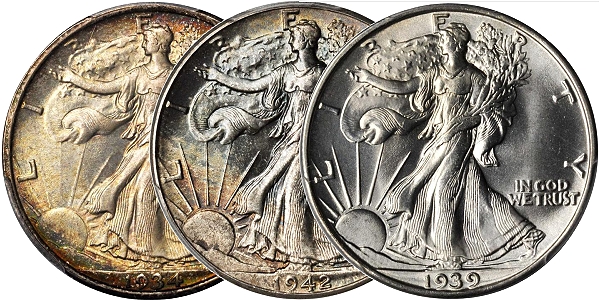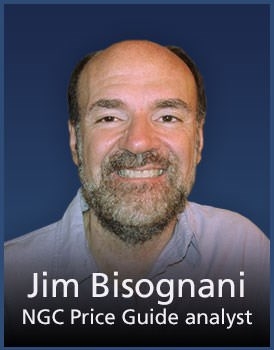
A closer look at collector demand for Ultra-Gem Walking Liberty Half Dollars
By Jim Bisognani for Numismatic Guaranty Corporation (NGC) ……
Spring is definitely here, my friends. What was brown has now turned vibrant green. Birds are singing and/or humming lively and welcome refrains. And outside activities are on the increase – ah! this is such a great time of year.
The harsh winter – though still in the minds of us New Englanders – has lessened. People are out and about, enjoying activities. Every day, I can see folks strolling in the neighborhood. Walkers everywhere, it seems.
According to a well-known East Coast dealer: “There are so many great values in the market today … where do I start?”
Well, since my dealer friend asked, I was quick to have him elaborate. First off, according to the source, are high-grade 20th-century type coins: those harboring lower populations.
“For me, bright white MS 67 Walkers ( Walking Liberty Half Dollar ) in general, but take the short series (1941 to 1947): These are enormous values at current levels. I have numerous want lists from serious collectors looking for Gem and better coins. You can still pick up type coins like the 1943 and 1945 in the $400-$500 range. They have just recently begun to move up; demand for the short series is driving them. These two dates and others have been overlooked for some time in the higher grade. Really, the prices have been depressed for several years.”
For reference I reviewed the Walking Liberty Half Dollar NGC Census, and of the nearly quarter of a million business-strike Walkers graded to date, only 4,340 coins (or less than 1.8%) have achieved MS 67!
With that said, the 1941 and 1943 (at 558 and 526, respectively, in the NGC Census) are leading the way, accounting for 25% of all those Walking Liberty Half Dollars garnering an MS 67 numeric designation.
My friend also was quick to point out two of his favorite “unknown” Philadelphia issues.
“I like the 1934 and 1937; take a look at the numbers in MS 67.”
I did, and currently 98 appear on the NGC Census for the 1934 and 77 for the 1937 Walking Liberty Half Dollars.
“These two dates are terrific to try and find in the $1,200-$1,400 range. I mean to find well-struck, blazing white coins at current levels is tough. There are many unattractive Walkers out there.”
This is true, and it goes for those folks in my neighborhood or the round discs on the bourse!
“While some collectors look for nicely toned coins, hands-down – when it comes to Walkers – they are looking for blazing white satiny surfaces.”
I, too, very much enjoy the splendid and iconic Adolph A. Weinman Walking Liberty Half Dollar. I mean, have you ever heard of a collector (or non-collector, for that matter) when in possession of a flashy, satiny white Walking Liberty Half Dollars they weren’t taken by the magnificent rendering? I was compelled to take a brief stroll down memory lane. I blew back in time with a flash drive and viewed my ever-expanding data collection. I opened a few files and took a quick look at the Blue Sheet from exactly a decade ago. I was actually fascinated with the results. Believe it or not, all four coins were dealer “Bid” at virtually the same levels!
May 23, 2008 Certified Coin Dealer Newsletter (Blue Sheet)
The following quartet of Walking Liberty Half Dollars “Bid” in MS 67

Surprisingly, the 1937 was trading below the 1941 and 1943 and actually only the 1942 was bid less at $555 in MS 67!
Now, a decade later, armed with more sales data…
According to the NGC US Coin Price Guide and NGC Census for MS 67 coins May 23, 2018:

Now for me, purely by the numbers, I feel that the 1934 and 1937 are particularly attractive at current levels. And based on the growing audience for the Walking Liberty Half Dollars short set , the high-grade coins (those in MS 67 and above) number very few to satisfy the average collector, as well as the serious registry set aficionado.
Just consider this tough trio from the abbreviated series of Walking Liberty Half Dollars: the 1942-S reports in at only 11 coins in the NGC Census compared with 24 for the key to the short set, 1941-S, followed close behind by the elusive San Francisco 1943-S with only 26 coins graded MS 67. Time and data certainly has a way of sorting things out. Take a look at the following valuations:

A decade ago, this NGC MS 67 trio combined was dealer “Bid” at $17,650, and today the average advance in value per this San Francisco Walking trio is a staggering 289%.
Although the series has a harvest of key dates, these are mostly centered on the cluster from the teens and 1920s. Don’t be discouraged: It is not impossible for the average collector to complete the series. I suggest concentrating on the 1916 through the end of the 1920s in an evenly matched, extremely fine grade.
Then, commencing with the 1930s through the end of the series, strive for mint state examples. They all don’t have to be ultra-Gem either! I would recommend a nice choice uncirculated MS 63 assemblage, and then, when budget allows, try and splurge for the occasional MS 67 late date Walker.
As always, beauty is in the eye of the coin beholder although, as my dealer friend put it, many will avoid the unattractive Walking Lady Liberty and target those flashy white satiny coins.
Until next time, happy collecting!
* * *
 Jim Bisognani is an NGC Price Guide Analyst having previously served for many years as an analyst and writer for another major price guide. He has written extensively on US coin market trends and values.
Jim Bisognani is an NGC Price Guide Analyst having previously served for many years as an analyst and writer for another major price guide. He has written extensively on US coin market trends and values.





What about 1944? I cant make out the city where minted.